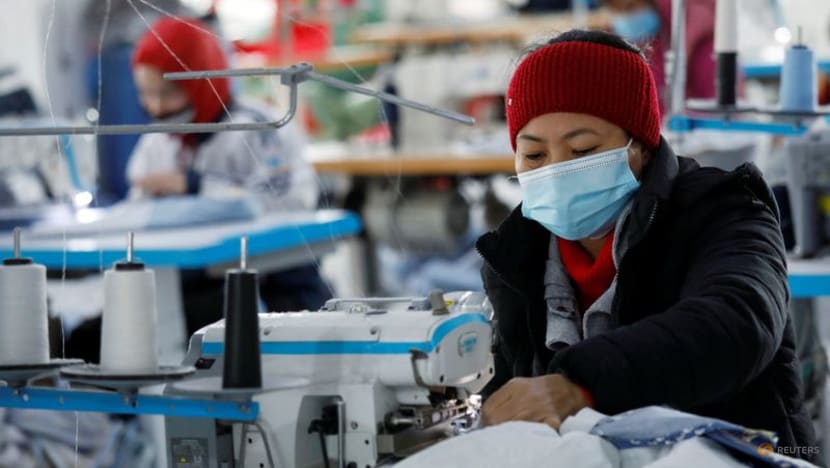Commentary: Has China’s great relocation helped Southeast Asia industrialise?
China’s extensive investments in the region have delivered mixed results, say these researchers.

Labourers work at a private garment factory in Hanoi, Vietnam, on Jan 8, 2021. (Photo: REUTERS/Kham)
SINGAPORE: In recent years, China’s manufacturers have increasingly shifted production to Southeast Asia, driven by rising labour costs, geopolitical tensions – particularly the US-China trade war – and efforts to diversify supply chains (the “China Plus One” strategy). This mirrors Japan’s manufacturing relocation in the 1980s to 1990s, which helped drive industrialisation in the region.
Yet the question remains: Will China’s “Great Relocation” foster Southeast Asia’s long-term development, or leave it toiling in the middle-income trap and unable to move up the technological and productivity ladder? With the US now threatening steep new tariffs on exports from Southeast Asian countries, the benefits of this shift may be at risk.
INVESTMENT, INFUSION, INNOVATION
Southeast Asia’s prospects for further industrialisation will depend on several factors related to China’s economic engagement in the region. These can be analysed using the World Bank’s three I’s framework: Investment, infusion, and innovation.
The impact of China’s investment in the region depends on volume and type. The average annual value of Chinese greenfield foreign direct investment (FDI) in manufacturing in ASEAN doubled from US$6.1 billion from 2016 to 2019 to US$12.9 billion from 2020 to 2023. In both periods, the average annual value of Chinese greenfield FDI in manufacturing was significantly larger than that from the US, Japan and South Korea.
In 2023, a third of manufacturing investment in Southeast Asia came from China alone. Five ASEAN countries – Vietnam, Thailand, Indonesia, Malaysia and Cambodia – ranked among the top 15 global recipients of Chinese manufacturing FDI from 2016 to 2023.
In countries like Cambodia and Vietnam, the total Chinese manufacturing FDI between 2016 and 2023 was significantly larger relative to their manufacturing value added and merchandise exports in 2016 (the base year). For example, the total Chinese manufacturing FDI to Cambodia between 2016 and 2023 was US$2 billion, compared to its manufacturing value added of US$3.2 billion and merchandise exports of US$8.5 billion in 2016.
However, manufacturing operations yield different development benefits, depending on the type of investment. Chinese investment that is capital-intensive and resource-oriented, such as Indonesia’s refining and processing industries, primarily supplies processed critical minerals back to China.
LIMITED SCOPE FOR GROWTH
Other export-oriented investments stand out for their location between China and the US in manufacturing supply chains. For example, a third of Chinese FDI in Vietnam’s manufacturing sector has gone into electronic components, semiconductors and communication equipment, boosting Vietnam’s global market share in electronics from 2.68 per cent in 2016 to 4.48 per cent in 2022.
Countries like Vietnam have benefited from China as a source of cheap raw and intermediate inputs and the US as a key export destination, allowing them to leverage both ends of the value chain. While contingent on the stability of the US-China-ASEAN trade, these export-oriented investments have significant potential to increase domestic productivity and competitiveness.
In some new growth fields, such as electric vehicles (EVs) in Thailand, Malaysia, Vietnam, and Indonesia, FDI often aims to boost local industrial upgrading and capacity, and in some cases to eventually substitute for imports. Such investment has the potential to build national brands through foreign-domestic joint ventures, but the scope for growth might be limited to the domestic and regional markets.
Infusion refers to how foreign investment and technology are absorbed into the local economies, boosting production capacity and productivity.
Chinese and other FDI have played a role in increasing manufacturing value added across Southeast Asia. Cambodia’s and Vietnam’s industrial sectors have grown, as reflected in the increasing share of manufacturing value added (per cent of gross domestic product) and employment (per cent of total employment) between 2016 and 2023.
PRODUCTIVE CAPABILITIES REMAIN STAGNANT
However, FDI has not necessarily brought about higher-value-added processes – for instance, front-end wafer manufacturing instead of back-end outsourced semiconductor assembly and testing – or spurred transitions to higher-value goods – for instance, from producing garments and footwear to electronic integrated circuits.
One indicator of this is the Economic Complexity Index (ECI), which measures a country’s productive capabilities by analysing the diversification and complexity of the export basket, a proxy for knowledge intensity in the economy. The ECI has notably risen in the Philippines, Vietnam, and even Myanmar since 2016, but remains stagnant in the other developing Southeast Asian countries.
Of the five ASEAN countries that received the most Chinese manufacturing FDI, Malaysia and Thailand have seen little improvement in ECI scores, while Indonesia and Cambodia remain relatively undiversified and less capable of producing sophisticated goods and services compared to the global median. These findings suggest that investment influxes have yet to translate into greater knowledge intensity in many economies.
Finally, innovation refers to the ability to develop and commercialise indigenous technologies. It is the last and most challenging step in escaping the middle-income trap.
Have recent investments helped Southeast Asia develop innovative or research and development (R&D) capabilities?
A firm-level analysis of recent Chinese investment in EVs, EV batteries and microelectronics shows that most R&D remains concentrated in Singapore. At the same time, resident patent applications have been rising across Southeast Asia, reflecting growing aspirations for domestic innovation. Countries are also investing in sovereign artificial-intelligence strategies, data centres, and computing infrastructure to support future technological development.
Yet, increasing labour costs, talent shortages exacerbated by brain drain, and weak incentives for foreign firms to share advanced technology mean Southeast Asia remains a manufacturing base rather than an innovation hub.
TRANSLATING THESE TO LONG-TERM GAINS
The region must continue to invest in workforce skills and create policies that enable transfers of deeper production or operational capability (the knowledge and skills to operate and control a production process) and innovative capability (the ability to carry out significant in-house R&D). The latter is something no previous wave of industrialisation in the region has achieved.
With new economic headwinds and a possible full-blown US-China trade war, China’s great relocation to Southeast Asia could slow down, with investors delaying or cancelling expansion or relocation. At the same time, concerns over Chinese import surges and competition in third markets may reinforce the case for building more resilient regional integrated supply chains.
To effectively navigate these headwinds – and turn them into long-term gains – Southeast Asia will need to continue addressing structural problems in its investment climate, including by building better-quality institutions, in line with its long-term strategic economic interest.
Complementing the surge in FDI with stronger local supply chain linkages, greater participation of domestic small and medium enterprises, and targeted support for skills and technology transfer will be essential. Only then could the region fully capitalise on foreign investment and further cement its reputation as a global manufacturing hub.
Maria Monica Wihardja is a visiting fellow and co-coordinator of the Media, Technology and Society Programme at ISEAS - Yusof Ishak Institute, and adjunct assistant professor at the National University of Singapore. Midzuki Low is an analyst in the Industry Research Department at Mizuho Bank based in Singapore. This commentary first appeared on ISEAS – Yusof Ishak Institute’s blog, Fulcrum.

















